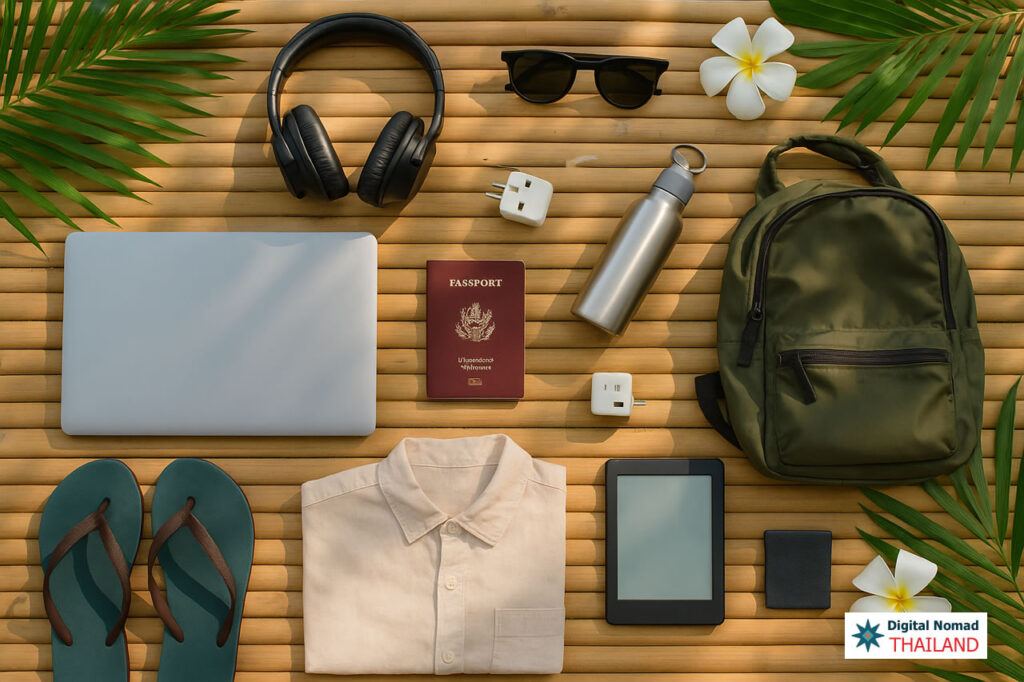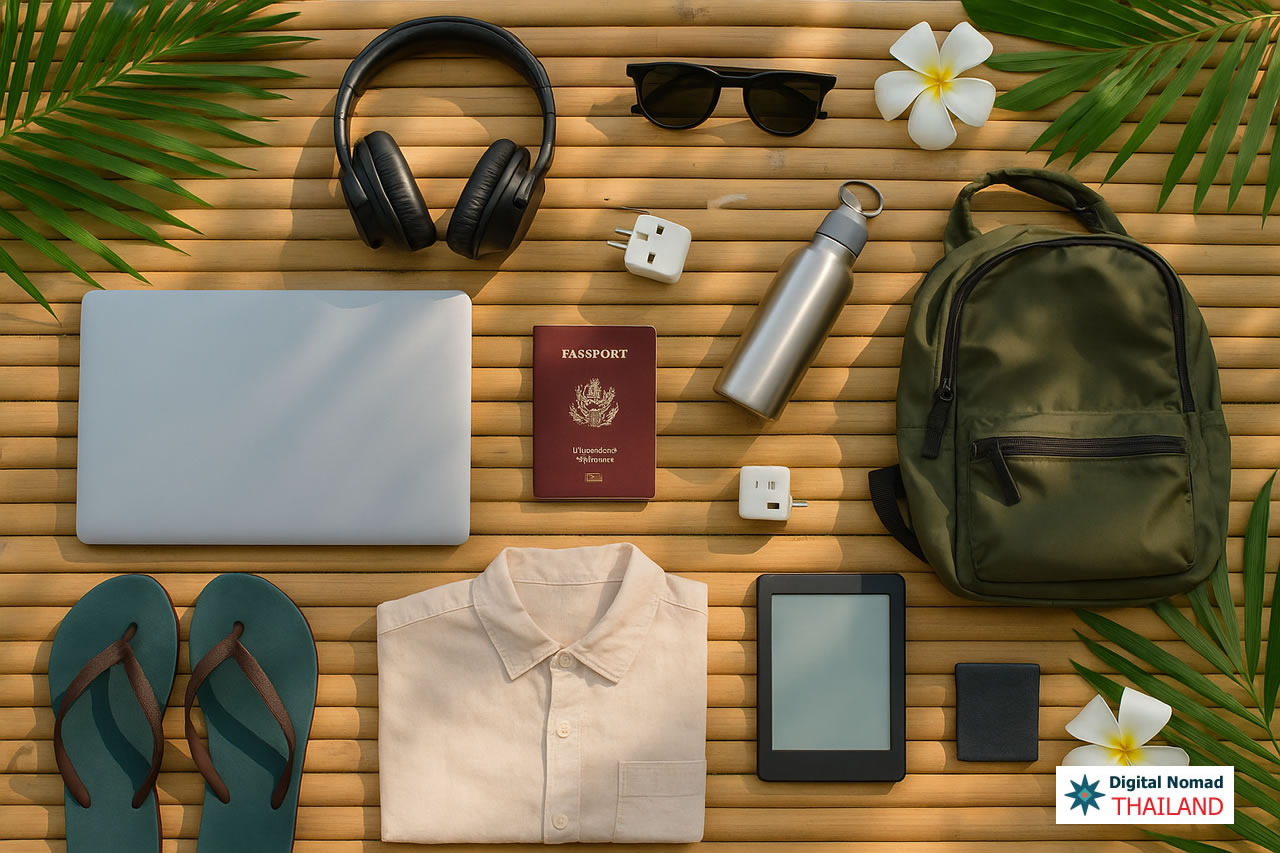
Packing for Thailand as a digital nomad isn’t just about throwing tech in a backpack and hoping for the best. Between the tropical climate, fast-moving lifestyle, and remote work needs, what you bring—and what you leave—can make a big difference.
This guide covers the essentials: gear that works, clothing that suits the weather, and a few easy-to-miss items that’ll save you hassle once you’re here. It’s not about packing light or heavy—it’s about packing smart.
Must-Have Gear
These are your digital nomad essentials—the core gear you’ll rely on every day. If you forget something else, you’ll probably be fine. But miss one of these, and you’ll feel it fast.
Laptop + Charger
This one’s obvious, but it’s worth stressing: don’t bring an outdated, slow, or unreliable laptop. Whether you’re editing videos, writing blog posts, coding, or running Zoom calls, your laptop is your mobile office.
Choose something lightweight and durable, ideally with:
- Long battery life (not all cafés have power outlets)
- Good cooling (Thailand is hot)
- International keyboard if you’re picky
Tip: Bring a spare charging cable—Thai electronics stores may not carry your model.
Universal Adapter
Thailand’s power sockets mostly use Type A, B, and C plugs, and the voltage is 220V at 50Hz. If you’re from Europe, Australia, or North America, your plugs might not fit.
A compact universal adapter with surge protection is a must. Bonus if it includes USB ports so you can charge your devices directly.
Avoid: bulky or cheap adapters with poor connections—they wear out fast.
Unlocked Smartphone
Thailand has excellent mobile coverage and cheap data plans—but you’ll need an unlocked phone to use local SIM cards.
Major providers like AIS, TrueMove, and DTAC offer tourist-friendly plans, but long-term nomads should skip those and go for regular prepaid packages instead. Expect to pay around ฿200–฿500/month for generous data. For a deeper breakdown of providers, see my guide to the Best SIM Cards for Digital Nomads in Thailand (2025)
Tip: You can pick up a SIM at the airport, convenience stores, or any mobile shop. Just bring your passport.
Portable SSD or Cloud Backup
Thailand is beautiful, but it’s humid—and electronics don’t love humidity. A rugged external SSD is the safest way to back up your data. They’re lightweight, fast, and more durable than traditional hard drives.
Alternatively, make sure your cloud storage is in order. Services like Google Drive, Dropbox, or iCloud work well here, thanks to fast Wi-Fi in most urban areas.
Don’t risk it: If your laptop dies or gets stolen, you’ll want your files somewhere safe.
Compact Daypack
You won’t carry your full travel backpack to cafés or coworking spaces. A slim, secure daypack is perfect for laptops, chargers, notebooks, and personal items.
Look for features like:
- Anti-theft zippers or hidden compartments
- Water-resistant material (helpful during rainy season)
- Lightweight but durable construction
Tip: If space is tight, consider a foldable or packable model that easily fits inside your main luggage.
USB Hub or Adapter Dongle
Newer laptops (especially MacBooks) come with limited ports. That’s a problem when you’re juggling external drives, headphones, HDMI, and SD cards.
A USB-C hub with multiple ports (USB-A, HDMI, SD, etc.) can save you a world of frustration. It’s small, light, and often overlooked—until you need it.
Tip: Some coworking spaces have shared accessories, but it’s hit or miss.
Clothing Essentials
Thailand’s tropical climate is no joke. It’s hot, it’s humid, and when it rains—it pours. You’ll sweat through heavy fabrics in no time, so packing the right clothes is all about comfort, breathability, and simplicity.
Lightweight, Breathable Clothing
Stick to quick-drying fabrics like cotton blends, rayon, or technical synthetics. You’ll want loose-fitting tops, shorts, and maybe a few tank tops. Dark colors hide sweat, but light colors feel cooler under the sun.
Also toss in swimwear—even if you’re not beach-hopping, pools are common in condos and co-living spaces.
Tip: Laundry is cheap and fast in Thailand, so you don’t need much—just enough for 5–7 days.
Smart-Casual Outfit
While most of Thailand is very laid-back, some situations call for a little effort—immigration visits, coworking meetups, or nicer dinners. Pack a clean collared shirt or blouse, a pair of decent pants or a skirt, and closed-toe shoes or neat sandals.
Flip-Flops + Comfortable Walking Shoes
Bring one basic pair of flip-flops to start—they’re perfect for daily life in Thailand, where it’s common to slip off your shoes before entering homes, cafés, massage shops, and even some stores. That said, you’ll find cheap flip-flops for sale on practically every street corner, so no need to overpack.
What’s more important is a good pair of comfortable walking shoes or lightweight sneakers. You’ll want solid support for exploring cities, going on day trips, or walking longer distances in the heat.
Light Rain Jacket or Poncho
If you’re coming during the rainy season (roughly May–October), pack something waterproof. A foldable rain jacket or light poncho will keep you dry without overheating. Umbrellas are everywhere, but a jacket is more practical when riding a motorbike or navigating crowded streets.
Health & Personal Care
Thailand has everything you need when it comes to personal care—but there are a few essentials you should bring with you to avoid hassle, higher costs, or limited availability.
Prescription Medications
If you take any prescription meds, bring enough for your stay plus a little extra—especially for hard-to-find brands. Keep medications in their original packaging, and bring a digital copy of your prescription just in case.
Some medications are available over the counter in Thailand, but not all, and brand names can vary. I’ve covered this in detail in my Prescription Medication in Thailand guide, which explains what you can buy locally, what requires a prescription, and what’s often unavailable.
Good to know: Pharmacies in Thailand are generally excellent. You’ll find them everywhere, even in smaller towns, and most pharmacists speak some English.
You don’t always need a prescription for basic meds, and prices are usually much lower than in the West. Local chains like Boots and Watsons carry international brands, but independent shops often offer the same items for less.
📌 For a full look at how to stay protected while living and working here, see our guide to Health Insurance for Digital Nomads in Thailand
Travel-Sized First Aid Kit
Nothing fancy. Just the basics:
- Plasters (band-aids)
- Painkillers (paracetamol, ibuprofen)
- Antiseptic cream or wipes
- Rehydration salts (great after food poisoning or heat exhaustion)
- Motion sickness or anti-diarrheal tablets (just in case)
📌 You can buy most of this in Thailand—but it’s handy to have a few essentials on hand right away.
Sunscreen
Yes, you can buy sunscreen in Thailand. But it’s often more expensive, especially high-SPF, non-greasy, or reef-safe formulas. Bring at least one small bottle of a brand you trust, especially if you burn easily or plan to spend time outdoors or at the beach.
Mosquito Repellent
Mosquitos are a fact of life, especially in the rainy season or rural areas. Local brands like Soffell work surprisingly well and are super cheap. But if you prefer DEET-free or natural repellents, bring your own supply.
Toiletries
Thailand has 7-Elevens on nearly every corner, so there’s no need to overpack shampoo, soap, or toothpaste. But if you use a specific brand of skincare, deodorant, or razors, bring a small supply—you may not find the exact version here.
Note: Tampons are less widely available than pads and usually found only in larger stores or expat supermarkets—worth bringing if you rely on them.
Paperwork & Docs
A little preparation here can save you major headaches later. Keep both physical and digital copies of your most important documents—you never know when you’ll need to show them at immigration, while checking into accommodation, or setting up a SIM card.
Passport (Keep It Accessible)
You’ll need your passport regularly in Thailand—for things like SIM cards, hotel check-ins, apartment rentals, or visa extensions. Keep it handy and in good condition.
- Make sure it has at least 6 months’ validity from your arrival date
- Keep a few blank pages for stamps and re-entry permits
- Carry digital and printed copies for backup
- Consider using a laminated copy for everyday ID when the real one isn’t required
Digital & Printed Copies of Important Documents
Upload scans of your key documents to the cloud (Google Drive, Dropbox, etc.), and keep a few printed copies as well. Useful in case your phone dies or Wi-Fi isn’t available.
Include copies of:
- Passport photo page
- Entry stamp or visa
- Travel insurance
- Flight confirmation (onward or return ticket)
- Accommodation booking (especially when first arriving)
Onward Travel Proof (if on a tourist visa or visa exemption)
Thai immigration often requires proof that you’ll leave the country before your visa or exemption runs out. Even if no one asks, it’s smart to have a booked flight or bus ticket out of Thailand, just in case.
Tip: Services like 12Go or onward ticket providers can help you generate a refundable or temporary booking.
Passport Photos (Optional but Handy)
Not a must, but having a few printed and digital passport-sized photos can save you time—especially if you’re planning to:
- Apply for visa extensions
- Rent a motorbike long-term
- Sign up for coworking memberships
📌 Photo shops are easy to find in Thailand and usually charge just ฿100–฿150 for a set. But if you’re arriving during a holiday, staying rural, or want to avoid errands, bring a few from home just in case.
Tech You’ll Actually Use
You don’t need to bring a suitcase full of electronics—but the right tech can make remote work and travel life a whole lot smoother. These are the tools digital nomads in Thailand actually use—not the ones collecting dust at the bottom of a packing cube.
Noise-Canceling Headphones
Coworking spaces are usually chill, but cafés can get noisy fast. Whether you’re on calls or just trying to focus, noise-canceling headphones are a game-changer.
Bonus: great for long flights, shared hostels, or city noise if you’re staying near a busy street.
Power Bank
You’ll burn through battery life fast if you’re using your phone for hotspotting, Grab rides, or navigating the streets. A good 10,000–20,000mAh power bank will get you through the day without hunting for outlets.
Tip: Make sure it’s airline-approved for carry-on.
SIM Card Cutter or eSIM Reader (Optional)
Most travelers can just buy a Thai SIM card at the airport or any 7-Eleven. But if you use a phone with eSIM capability, setting it up ahead of time (e.g. with AIS or Airalo) can save time on arrival.
Note: Dual-SIM setups are great for keeping your home number active alongside a Thai line.
VPN Subscription
A solid VPN (Virtual Private Network) is highly recommended. Not because Thailand blocks content (it rarely does), but for:
- Securing public Wi-Fi connections
- Accessing geo-restricted sites or banking apps
- Keeping your data safe at airports, hostels, or coworking spaces
Popular options: NordVPN, Surfshark, ExpressVPN.
Travel Adapter with USB Ports
We mentioned this earlier, but it’s worth repeating—a compact universal adapter with multiple USB slots will simplify your setup, especially if you’re charging several devices at once.
What to Leave Behind
It’s easy to overpack, especially if this is your first long trip. But trust me—Thailand is one of the easiest places to live light. Most of what you think you might need is already available here, usually cheaper and more climate-appropriate.
Here’s what to skip:
Heavy Clothing (Jeans, Jackets, Coats)
Unless you’re heading to Chiang Mai in December, you won’t need heavy layers. Thailand is hot and humid nearly year-round.
Do bring: one light jacket or long-sleeve for flights or chilly malls. That’s it.
Too Many Toiletries
Full-size bottles of shampoo, conditioner, and body wash just waste space and weight. 7-Elevens and pharmacies stock everything you’ll need, often in travel sizes.
Exceptions: specialty items like organic skincare or specific Western brands—bring those if you’re picky.
Large Towels
Bulky, slow to dry, and easy to replace. If you really want one, go for a microfiber travel towel. Otherwise, your accommodation will likely provide one.
Books
Physical books take up space and weight. Unless you’re attached to a particular copy, go digital with a Kindle or e-reader. Thailand has bookstores in major cities, but they’re not always stocked with English titles.
Expensive Jewelry or Flashy Gear
Leave the bling at home. Not only will it make you stand out, but it also increases the risk of theft or just looking like a walking ATM. Thailand is casual—nobody’s judging your watch brand.
Optional But Nice to Have
You don’t need these items—but if you’ve got the space, they can make your nomad life a little easier, more organized, or just more enjoyable.
Travel Yoga Mat or Foldable Fitness Gear
Staying fit on the road is easier with a lightweight yoga mat or resistance bands. Many apartments and co-living spaces have gyms, but not always mats or clean floors.
Reusable Water Bottle
Thailand is hot, and staying hydrated matters. A collapsible or insulated bottle saves plastic and comes in handy during day trips, hikes, or long work sessions at cafés.
Compact Surge Protector
Power outages and dodgy sockets do happen, especially in smaller towns or islands. A small surge protector with USB ports protects your devices and makes it easier to charge multiple things at once.
Kindle or E-Reader
If you’re a reader, this is a lifesaver. Books in English are limited and pricey in Thailand—download what you need in advance and read on the go, no bulk or weight.
Dry Bag or Waterproof Pouch
Thailand = water. Whether it’s Songkran, boat trips, or unexpected downpours, a dry bag or waterproof phone pouch can save your gear from a soggy death.
Packing for Thailand as a digital nomad doesn’t have to be stressful. The real secret? You don’t need much—just the right essentials and a flexible mindset. Thailand makes it easy to live well with less.
Most things can be bought locally if you forget them, and chances are, you’ll shed a few items once you settle in anyway. Focus on gear that keeps you productive, clothes that keep you cool, and a setup that keeps you moving.
So pack smart. Travel light. And leave some room for the unexpected—that’s half the fun of living the nomad life in Thailand.
💬 Got a favorite item that saved your trip—or something you wish you’d left behind? Drop your tips in the comments!

